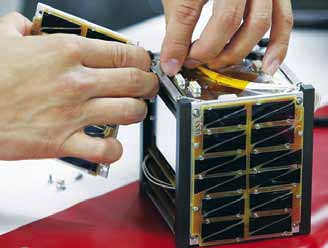The UCLA team says that the new kind of polymer solar cell produces energy by absorbing mainly infrared light, not visible light, making the cells almost 70 per cent transparent to the human eye. They made the device from a photoactive plastic that converts infrared light into an electrical current.
Scientists are said to be investigating polymer solar cells for their potential in making unique advances for broader applications. Several such applications would be enabled by high-performance visibly transparent photovoltaic (PV) devices, including building-integrated photovoltaics and integrated PV chargers for portable electronics.
Homemade satellite all set for space
After working for years on a homemade satellite cobbled together from electronics store parts, Song Hojun is all set to launch it into orbit later this year.
“Making a satellite is no more difficult than making a cellphone. I believe that not just a satellite, but anything can be made with the help of the Internet and social platforms. I chose a satellite to show that symbolically,” The Telegraph quoted the South Korean artist as saying.
Song’s internship at a satellite company inspired him to start the Open Satellite Initiative. He was lucky enough to get space professionals from Slovenia to Paris for all the required information he needed with the launch. Also, he had a small electronic business running and had enough support from his parents who helped him with funds.

“The cubical OpenSat weighs 1 kg and measures 10 cubic centimetres. It will transmit information about the working status of its battery, the temperature and rotation speed of the satellite’s solar panel. Radio operators will be able to communicate with the satellite. If all goes well, it will repeat a message in Morse code using its LED lights at a set time and location,” the report by The Telegraph said.
Song has plans to launch the satellite from the BaikonurCosmodrome in Kazakhstan in December with another satellite.
Programmable T-shirt
Say hello to tshirtOS—a programmable T-shirt that displays whatever you want (tweets, Facebook statuses or pictures of your cat). The T-shirt has a built-in screen for displaying tweets, Facebook posts or Instagram pictures. The “100 per cent cotton T-shirt” is washable too! The microprocessor on the T-shirt wirelessly connects to an iOS app on your iPhone, allowing you to control the display.
CuteCircuit, the company behind tshirtOS, plans to soon conduct product tests. It will start mass producing the smart-shirts depending on how many folks register interest.
The tshirtOS includes audio playback via a headphone jack. The camera used is claimed to be the smallest in the world. It measures just 2.5×2.9×2.5 mm3 and comes from Omnivision. However, it captures at a resolution of only 32×32. The display consists of 1024 ultrathin RGB LEDs, which all connect back to a small PCB that has Bluetooth, USB, an accelerometer and a pair of headphone sockets.
Artificial photosynthesis system
Japanese electronics maker Panasonic has developed an artificial photosynthesis system that uses sunlight to convert carbon dioxide (CO2) into organic material (called formic acid) at an efficiency of 0.2 per cent. This development will make it possible to realise a simple and compact system for capturing and converting wasted carbon dioxide from incinerators and electric generation plants, according to the company.
The efficiency is said to be on a comparable level with real plants used for biomass energy. What makes this artificial photosynthesis system simple and efficient is the application of a nitride semiconductor.
“We found that a nitride semiconductor has the capability to excite the electrons with enough high energy for the CO2 reduction reaction. Nitride semiconductor has attracted attention for its potential applications in highly efficient optical and power devices for energy saving. However, its potential was revealed to extend beyond solid devices; more specifically, it can be used as a photo-electrode for CO2 reduction. Making a device structure through the thin film process for semiconductors, the performance as a photo-electrode has highly improved,” the company says in a release.
Computer that can print 3D drugs
While learning about the concept of 3D printers, Lee Cronin, the leader of a team of 45 researchers at Glasgow University, mulled over turning such a device into a universal chemistry set that could make its own drugs.
“What Apple did for music, I’d like to do for the discovery and distribution of prescription drugs,” The Guardian quoted Cronin as saying.






